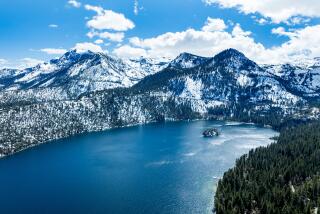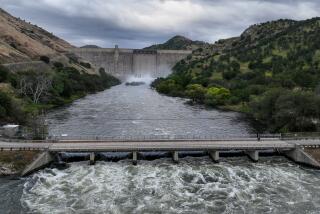Airborne laboratory being used to measure California’s snowpack
Teams will fan out across the Sierra Nevada on Thursday to perform their final snow survey of the season, a closely watched rite of spring that helps determine how much water will flow to farms and cities in coming months.
But 18,000 feet above the Sierra slopes, an airborne experiment is underway that could revolutionize that ritual.
Starting in early April, researchers have made weekly flights over the upper Tuolumne River basin, taking sophisticated instrument readings of the snow depth and reflected sunlight. The information, coupled with data from the ground measurements, promises to paint the most comprehensive snowpack picture that water managers have ever had.
“This is the first time that we’ve actually known how much water there is,” said Tom Painter, a scientist with NASA’s Jet Propulsion Laboratory in La Cañada Flintridge who is overseeing the aerial project with the California Department of Water Resources.
The West’s mountain snowpack forms a crucial natural reservoir, melting into runoff that rules dam operations and water allocations from California to the Rocky Mountains.
Water managers started measuring the snowpack a century ago, developing a simple system that remains in use today. Surveyors with water agencies and utilities snap on cross-country skis once a month during the winter and early spring and return to several hundred alpine spots year after year to measure the snow’s water content.
They drive hollow aluminum tubes into the snow, measure the snow depth and then weigh the snow-filled tubes to determine the snow’s water volume. In recent decades, the manual measurements have been supplemented with snow pillows — large electronic scales installed at various mountain locations that automatically weigh the snow accumulated on the pillow.
The readings are fed into a computer, along with precipitation and stream flow statistics and historic data, to produce the spring and summer runoff forecasts.
“It works very well and would still be something we would rely on quite heavily,” said state snow survey chief Frank Gehrke, who is working on the airborne project with Painter. “But even now, in relatively dry years and relatively wet years, it tends to break down a little bit.”
And in the southern Sierra, roughly a third of the watershed is above the highest measurement point.
“There’s a whole lot of things going on up in the watershed and right now we don’t know how much snow is left up there,” said Gehrke, who has been conducting snow surveys for more than three decades.
The airborne snow observatory, as the flying laboratory is called, can fill in those data gaps. A DeHavilland Twin Otter turboprop flying out of the Mammoth Yosemite Airport has been outfitted with a remote sensing instrument that uses lidar technology to shoot out 100,000 pulses of light a second to measure the surface elevation. When researchers compare the readings with lidar measurements taken of bare ground last summer on the same flight path, they can calculate the precise snow depth.
Another instrument, a spectrometer, measures the albedo, or reflectivity of the snow, to gauge the amount of energy the snow is absorbing from the sun, an indication of the melt rate.
Put it all together and researchers hope that they can significantly improve the accuracy of runoff forecasts, helping farmers plan crops and giving managers of the state’s biggest water supply projects a better idea of the amount and timing of water flowing into their reservoirs.
This is the first of three years in the pilot project, which will continue weekly flights over the Tuolumne River basin — the source of San Francisco’s water — through June. The $1.2-million-a-year experimental program, jointly funded by NASA and the state water resources department, is likely to add flights over neighboring river basins next year.
Painter, who joined JPL from the University of Utah three years ago, said he has been working 80-hour weeks for the last 18 months to launch the project.
“I spend a lot of time looking at snow-water equivalent maps now,” he said, adding that the incoming data “are beautiful.”
A warming climate is expected to significantly shrink the California snowpack, while also increasing the frequency of severe storms that could lead to flooding.
“The problems we have are not going away,” Gehrke said. If “we can significantly improve over time our runoff volume forecasts, that will help to … more accurately allocate those supplies.”
More to Read
Sign up for Essential California
The most important California stories and recommendations in your inbox every morning.
You may occasionally receive promotional content from the Los Angeles Times.











